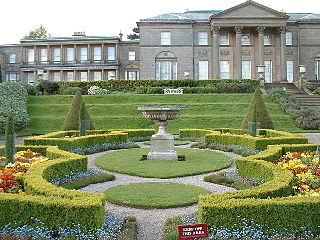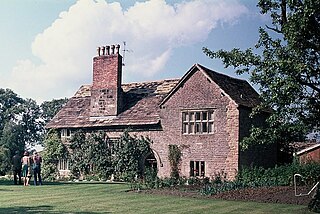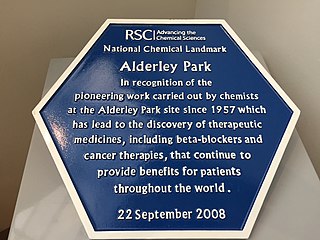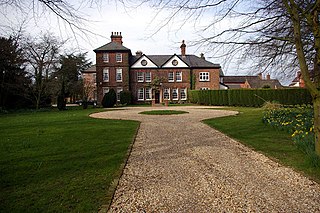
Baron Stanley of Alderley, in the County of Chester, is a title in the Peerage of the United Kingdom. It was created in 1839 for the politician and landowner Sir John Stanley, 7th Baronet. Upon his death in 1850, he was succeeded as 2nd Baron Stanley of Alderley and 8th Baronet of Alderley Hall by his son Edward, who was a prominent Liberal politician and notably served as President of the Board of Trade, Postmaster General and had in 1848 been created Baron Eddisbury, of Winnington in the County Palatine of Chester, in his own right. His wife Henrietta was a prominent campaigner for women's education. After his death, the Stanley of Alderley and Eddisbury baronies remained united; most holders have since chosen to be known as Lord Stanley of Alderley. The 3rd Baron Stanley of Alderley had a career in the Diplomatic Service; as he was childless he was succeeded by his younger brother, the 4th Baron. He was liberal member of parliament for Oldham. In 1909, the 4th Baron Stanley of Alderley acquired a further title when he succeeded his first cousin once removed, the Earl of Sheffield, according to a special remainder and thus inherited the title of 4th Baron Sheffield. After his death the titles passed to his son, the 5th Baron Stanley of Alderley. He was Liberal Member of Parliament for Eddisbury and also served as Governor of Victoria. His eldest son, the 6th Baron Stanley of Alderley, sold the family seat of Alderley Hall in 1938. He was married four times, the second time to Sylvia Ashley. On his death the titles passed to his younger brother, who preferred to be known as Lord Sheffield. He only held the titles for three months. As of 2013 the titles are held by the latter's cousin, the 9th Baron Stanley of Alderley, who succeeded his father in that year. He is the grandson of Oliver Hugh Stanley, youngest son of the 4th Baron.

Alderley Edge is a village and civil parish in Cheshire, England. In 2011, it had a population of 4,780.

Tabley House is an English country house in Tabley Inferior, some 3 kilometres (1.9 mi) to the west of the town of Knutsford, Cheshire. The house is recorded in the National Heritage List for England as a designated Grade I listed building. It was built between 1761 and 1769 for Sir Peter Byrne Leicester, to replace the nearby Tabley Old Hall, and was designed by John Carr. The Tabley House Collection exists as an exhibition showcased by the University of Manchester.

Tatton Park is a historic estate in Cheshire, England, north of the town of Knutsford. It contains a mansion, Tatton Hall, a medieval manor house, Tatton Old Hall, Tatton Park Gardens, a farm and a deer park of 2,000 acres (8.1 km2). It is a popular visitor attraction and hosts over a hundred events annually. The estate is owned by the National Trust, and managed under lease by Cheshire East Council . Since 1999, it has hosted North West England's annual Royal Horticultural Society flower show.

Nether Alderley Mill is a 16th-century watermill located in Congleton Road, to the south of the village of Nether Alderley, Cheshire, England. It is owned by the National Trust, and is recorded in the National Heritage List for England as a designated Grade II* listed building. It is a unique example of a triple overshot waterwheel system, two of which are in working order. It is one of only four virtually complete corn mills in Cheshire.

Nether Whitacre is a small village and larger rural civil parish in North Warwickshire, Warwickshire, England.

Mobberley is a village in Cheshire, England, between Wilmslow and Knutsford, which in 2001 had a population of 2,546, increasing to 3,050 at the 2011 Census.

St Mary's Church is an Anglican church at the end of a lane to the south of the village of Nether Alderley, Cheshire, England. It dates from the 14th century, with later additions and a major restoration in the late-19th century. The church is recorded in the National Heritage List for England as a designated Grade I listed building.
Winnington Hall is a former country house in Winnington, now a suburb of Northwich, Cheshire, England. It is recorded in the National Heritage List for England as a designated Grade I listed building. The building is in effect two houses joined, an older modest timber-framed house, and a newer, more elegant, stone house.

Nether Alderley is a village and civil parish in Cheshire, England, on the A34 a mile and a half south of Alderley Edge. The civil parish includes the hamlets of Monk's Heath and Soss Moss.

St Catherine's Church, Over Alderley, also known as St Catherine's Church, Birtles, stands in an isolated position in Birtles Lane, near to Birtles Hall, in the civil parish of Over Alderley, Cheshire, England. It is recorded in the National Heritage List for England as a designated Grade II* listed building. It was originally a private chapel for the Hibbert family and is now a parish church. It is unusual in that its tower is octagonal. It contains furnishings and stained glass from Germany and the Netherlands. The church is listed in England's Thousand Best Churches. It is an active Anglican church in the diocese of Chester, the archdeaconry of Macclesfield and the deanery of Knutsford. Its benefice is combined with that of St Mary, Nether Alderley.

Chorley Old Hall is a moated manor house on the B5359 road to the southwest of Alderley Edge, Cheshire, England. The house is recorded in the National Heritage List for England as a designated Grade I listed building, and the moated site is a scheduled monument. It is the oldest inhabited country house in Cheshire and consists of two ranges, one medieval and the other Elizabethan.

Peover Hall is a country house in the civil parish of Peover Superior, commonly known as Over Peover, Cheshire, England. It is recorded in the National Heritage List for England as a designated Grade II* listed building.

Tatton Old Hall is a historic building in Tatton Park near Knutsford, Cheshire, England. It is designated by English Heritage as a Grade II* listed building which is owned by the National Trust and administered in conjunction with Cheshire East Council. It is also known as one of the most haunted houses in Britain and is home to The Haunted Hunts official haunted collection. Paranormal investigations take place on a monthly basis under the guidance of The Haunted Hunts team. Its site is a Scheduled Ancient Monument.

Alderley Park was a country estate at Nether Alderley, Cheshire, England, between Macclesfield and Knutsford. It was the residence of the Stanley family of Alderley from the 1500s. It became the headquarters of ICI Pharmaceuticals in the 1950s. It was purchased from AstraZeneca by Bruntwood in 2014. The site has an international reputation as a home for bio and life sciences.

Heawood Hall is a country house, now divided into three houses, southwest of the village of Nether Alderley, Cheshire, England. It originated in the late 17th century; a tall wing was added in the 18th century. Further alterations were made in 1899, and again in the 20th century. It is constructed in red brick with buff sandstone dressings, and is roofed with Welsh slate. Figueirdo and Treuherz describe it as "a complicated and disjointed-looking house". The three houses are named Heawood Chase, Heawood Hall and Heawood House. The building as a whole is recorded in the National Heritage List for England as a designated Grade II listed building.

Soss Moss Hall is a former manor house in the parish of Nether Alderley, Cheshire, England. It was built in 1583 for Thomas Wyche. The architectural writers Figueirdo and Treuherz consider that, because of duplication of some of the timbers, it was built in two stages. Between 1835 and 1940 the kitchen of the house was used as Nether Alderley Methodist Chapel. The house was extended in the early 17th century and alterations were made during the 20th century. It is a timber-framed building on a sandstone plinth, with some repairs in brick. The infill is partly with brick, and partly with plaster. It is roofed in Kerridge stone slate, with stone ridges. The house has a H-shaped plan. It has two storeys, the north front having three gables, all of which have black-and-white herringbone decoration. On the left side is a massive stone chimney with three stacks, serving three fireplaces; it contains garderobes. The house is recorded in the National Heritage List for England as a designated Grade II* listed building.

The ruin of Tabley Old Hall is on an island surrounded by a moat in the civil parish of Tabley Inferior, about 1.5 miles (2.4 km) to the west of Knutsford, Cheshire, England. The ruin is recorded in the National Heritage List for England as a designated Grade II* listed building, and the moated site on which it stands is a scheduled monument.
Great Warford is a civil parish in Cheshire East, England. It contains six buildings that are recorded in the National Heritage List for England as designated listed buildings. Of these, one is listed at Grade II*, the middle grade, and the others are at Grade II. Apart from the village of Great Warford, the parish is almost entirely rural. The listed buildings consist of a house, a cottage, a farmhouse, a Chapel, the most spectacular is Highgrove built in 1903 as a Convalescent home for Ancoats Hospital in Manchester and its lodge after which the road is named.
Nether Alderley is a civil parish in Cheshire East, England. It contains 56 buildings that are recorded in the National Heritage List for England as designated listed buildings. Of these, one is listed at Grade I, the highest grade, four are listed at Grade II*, the middle grade, and the others are at Grade II. The parish contains the village of Nether Alderley. The largest house in the parish was the Old Hall which was damaged by fire in 1779. This was replaced on a different site by Park House in Alderley Park. This was in turn damaged by fire in 1931, and was demolished in 1933. Much of the park has since been used by a major pharmaceutical company.


















